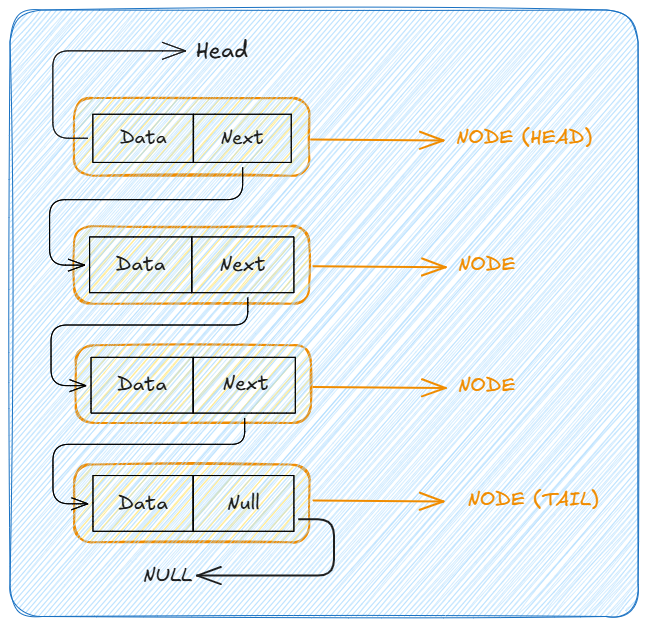嗨?,欢迎回到链接列表的这个系列。在上一篇文章中,我们了解了链表的基础知识,包括它们的定义、术语、与数组的区别以及链表的类型。我承诺我们会更深入地研究链表的实现,所以让我们开始吧。

正如我们在上一篇文章中了解到的,链接列表是编程世界中的基本数据结构。它们由节点组成,其中每个节点包含数据和对序列中下一个节点(在单链表中)或下一个和上一个节点(在双向链表中)的引用(或链接)。与数组不同,链表不会将元素存储在连续的内存位置,从而允许高效的插入和删除。
理解链表的概念对于掌握数据结构和算法至关重要。在本文中,我们将从单链表的基础知识开始,深入探讨链表的实现。
单链表是最简单的链表类型,其中每个节点都指向序列中的下一个节点。就像下图一样。

现在,是时候开始实现我们的单链表基本操作了。我们可以吗?
让我们从创建一个新的 Node 类开始。 Node 类将有一个构造函数,用于接收节点的数据和一个初始设置为 null 的下一个指针。
// Node class for Singly Linked List
class Node {
constructor(data) {
this.data = data;
this.next = null;
}
}
这个新创建的 Node 类(代表链表中的一个节点)可以如下图所示。

在继续之前,让我们创建一个 SinglyLinkedList 类的新实例来保存我们的链表操作。
// Singly Linked List class
class SinglyLinkedList {
constructor() {
this.head = null;
}
// Operations come here ?
}
class SinglyLinkedList {
constructor() {
this.head = null;
}
// Previous `SinglyLinkedList` class codes here ?
// .
// .
// .
// Insert at the beginning
insertAtBeginning(data) {
const newNode = new Node(data); // Create a new node with the given data
newNode.next = this.head; // Set the new node's next pointer to the current head
this.head = newNode; // Update the head to be the new node
}
// Other operations come here ?
// .
// .
// .
}
说明:插入到开头就像新人插在最前面一样。他们成为新的第一人称,链接到之前的第一人称。
class SinglyLinkedList {
constructor() {
this.head = null;
}
// Previous `SinglyLinkedList` class codes here ?
// .
// .
// .
// Insert at the end
insertAtEnd(data) {
const newNode = new Node(data); // Create a new node with the given data
// check if the list does not have a head i.e the list is empty
// NOTE: Every non-empty linked list will have a head
if (!this.head) {
this.head = newNode; // If the list is empty, set the new node as the head
return;
}
let current = this.head; // Start at the head of the list
while (current.next) {
current = current.next; // Move to the next node in the list by updating the current node
}
current.next = newNode; // Set the next pointer of the last node to the new node
}
// Other operations come here ?
// .
// .
// .
}
说明:在末尾插入就像有人在最后加入队伍一样。我们需要走到最后找到最后一个人,然后将他们链接到新的人。
class SinglyLinkedList {
constructor() {
this.head = null;
}
// Previous `SinglyLinkedList` class codes here ?
// .
// .
// .
// Delete a node
deleteNode(data) {
if (!this.head) return; // If the list is empty, do nothing
if (this.head.data === data) {
this.head = this.head.next; // If the node to delete is the head, update the head to the next node
return;
}
let current = this.head;
while (current.next) {
if (current.next.data === data) {
current.next = current.next.next; // If the node to delete is found, update the next pointer to skip it
return;
}
current = current.next;
}
}
// Other operations come here ?
// .
// .
// .
}
说明:删除一个节点就像队伍中间的某个人决定离开。我们找到那个人并将他们之前的人与他们之后的人联系起来。
class SinglyLinkedList {
constructor() {
this.head = null;
}
// Previous `SinglyLinkedList` class codes here ?
// .
// .
// .
// Search note
search(data) {
let current = this.head; // Start at the head of the list
while (current) {
if (current.data === data) {
// If the data is found, return true
return true;
}
current = current.next; // Move to the next node
}
return false;
}
// Other operations come here ?
// .
// .
// .
}
解释: 搜索节点就像尝试在队列中查找特定的人。我们从前面开始询问每个人,直到找到他们或到达终点。
class SinglyLinkedList {
constructor() {
this.head = null;
}
// Previous `SinglyLinkedList` class codes here ?
// .
// .
// .
traverse() {
let current = this.head; // Start at the head of the list
while (current) {
console.log(current.data); // Print the data of the current node
current = current.next; // Move to the next node
}
}
}
// End of class
说明:穿越就像沿着队伍走并问候每个人。我们从前面开始,一直前进,直到到达终点。
在本文中,我们了解了链表的基本操作以及如何在 JavaScript 中实现它们。在下一篇文章中,我们将学习双向链表。
记住,掌握链表需要练习。继续解决问题并在各种场景中实现这些数据结构。
确保您不会错过本系列的任何部分,并与我联系以更深入地讨论软件开发(Web、服务器、移动或抓取/自动化)、数据结构和算法以及其他令人兴奋的技术主题,请关注我:
敬请期待并祝您编码愉快????
以上是如何在 JavaScript 中实现单向链表的详细内容。更多信息请关注PHP中文网其他相关文章!




